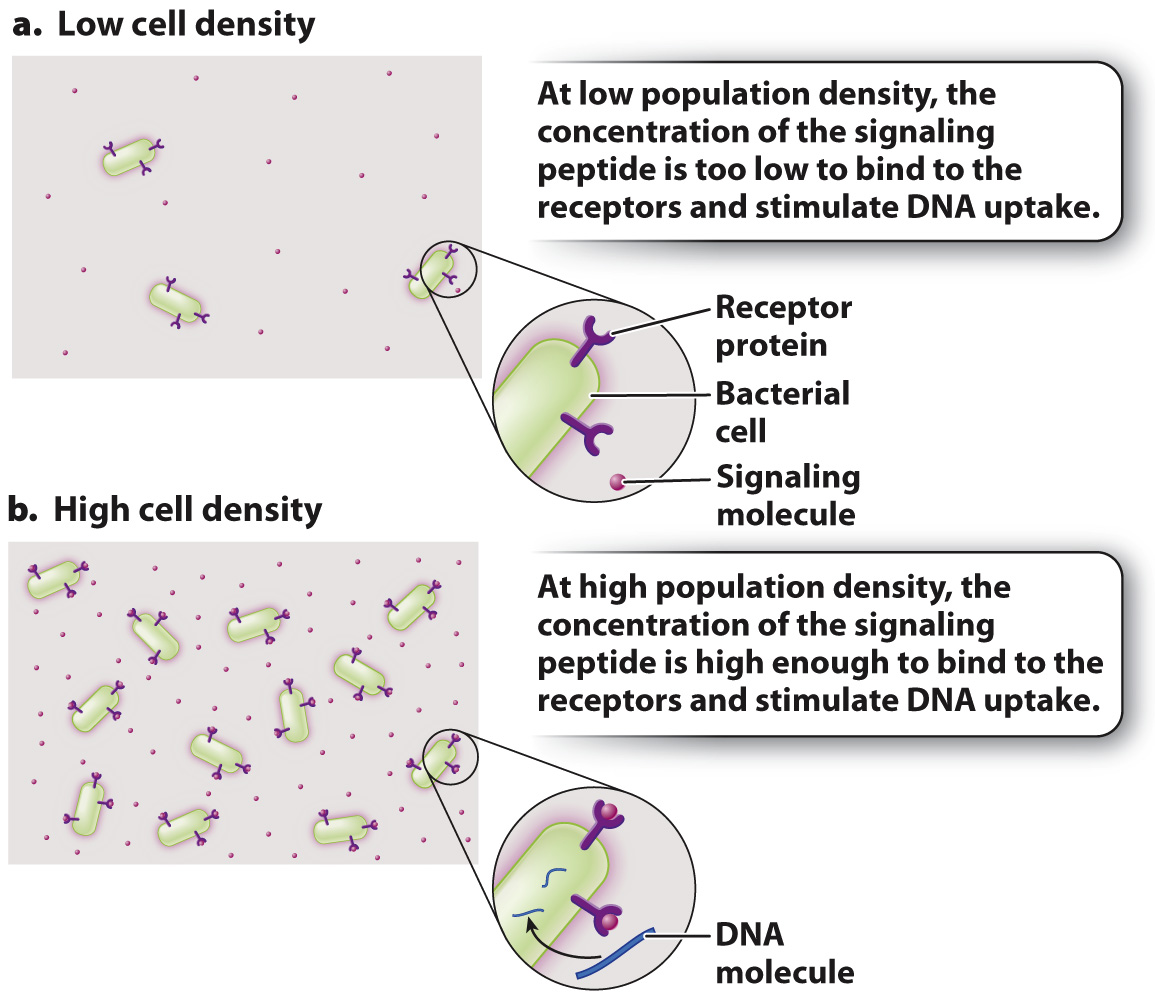Cells communicate using chemical signals that bind to specific receptors.
Cellular communication consists of four essential elements: a signaling cell, a signaling molecule, a receptor protein, and a responding cell (Fig. 9.1). The signaling cell is the source of a signaling molecule. Signaling molecules vary immensely and include peptides, lipids, and gases. In all cases, the signaling molecule carries information from one cell to the next. The signaling molecule binds to a receptor protein on or in the responding cell. As a result, there is a change in activity or behavior of the responding cell.

Let’s consider a simple example that we are all familiar with. You’re startled or scared, and you experience a strange feeling in the pit of your stomach and your heart beats faster. Collectively, these physiological changes are known as the “fight or flight” response. For these changes to occur, a signal goes from signaling cells to responding cells in the stomach, heart, and other organs. This signal is the hormone adrenaline (also called epinephrine). In response to stress, adrenaline is released from the adrenal glands, located above the kidneys. Adrenaline circulates through the body and acts on many types of cell, including the cells of your heart, causing it to beat more strongly and quickly. When the heart beats more strongly and quickly, it is able to deliver oxygen more effectively to the rest of the body.
This example illustrates the four basic elements involved in cellular communication. In this case, the signaling cells are specific cells within the adrenal glands. The signaling molecule is the hormone adrenaline released by these cells. Adrenaline is carried in the bloodstream and interacts with receptor proteins located on the surface of responding cells, like those of the heart.
Quick Check 1 If a hormone is released into the bloodstream and therefore comes into contact with many cells, what determines which cells in the body respond to the hormone?
Quick Check 1 Answer
Only cells that have receptors for the hormone respond to the signal. Therefore, signaling can be specific for particular cells.
Let’s look at a second example, this time involving communication among bacteria (Fig. 9.2). Streptococcus pneumoniae (also known as pneumococcus) is a disease-

In the 1960s, it was observed that the rate of DNA uptake by pneumococcal cells increased sharply once the bacterial population reached a certain density. Scientists concluded that the bacteria were able to coordinate DNA uptake across the population so that uptake occurred only at high bacterial population density. How is it possible that these bacteria “know” how many other bacteria are present? It turns out that these bacteria are able to communicate this information to one another through the release of a small peptide.
In the 1990s, scientists discovered a short peptide consisting of 17 amino acids that is continuously synthesized and released by pneumococcal cells. Not long after, a receptor for this peptide was discovered on the surface of the pneumococcal cells. The binding of this peptide to its receptor causes a bacterium to express the genes required for DNA uptake. When the bacteria are at low density, the peptide is at too low a concentration to bind to the receptor (Fig. 9.2a). As the population density increases, so does the concentration of the peptide, until it reaches a level high enough to bind to enough receptors to cause the cells to turn on genes necessary for DNA uptake (Fig. 9.2b).
This is an example of quorum sensing, a process by which bacteria are able to determine whether they are at low or high population density and then turn on specific genes across the entire community. It is used to control and coordinate many different types of bacterial behaviors, such as bioluminescence, antibiotic production, and biofilm formation.
This example also illustrates the four essential elements involved in communication between cells. In this case, however, each bacterial cell is both a signaling cell and a responding cell because each cell makes the signaling molecule and its receptor. Nevertheless, the general idea that cells are able to communicate by sending a signaling molecule that binds to a receptor on a responding cell is universal among both prokaryotes and eukaryotes. These four elements act in very much the same way in diverse types of cellular communication.